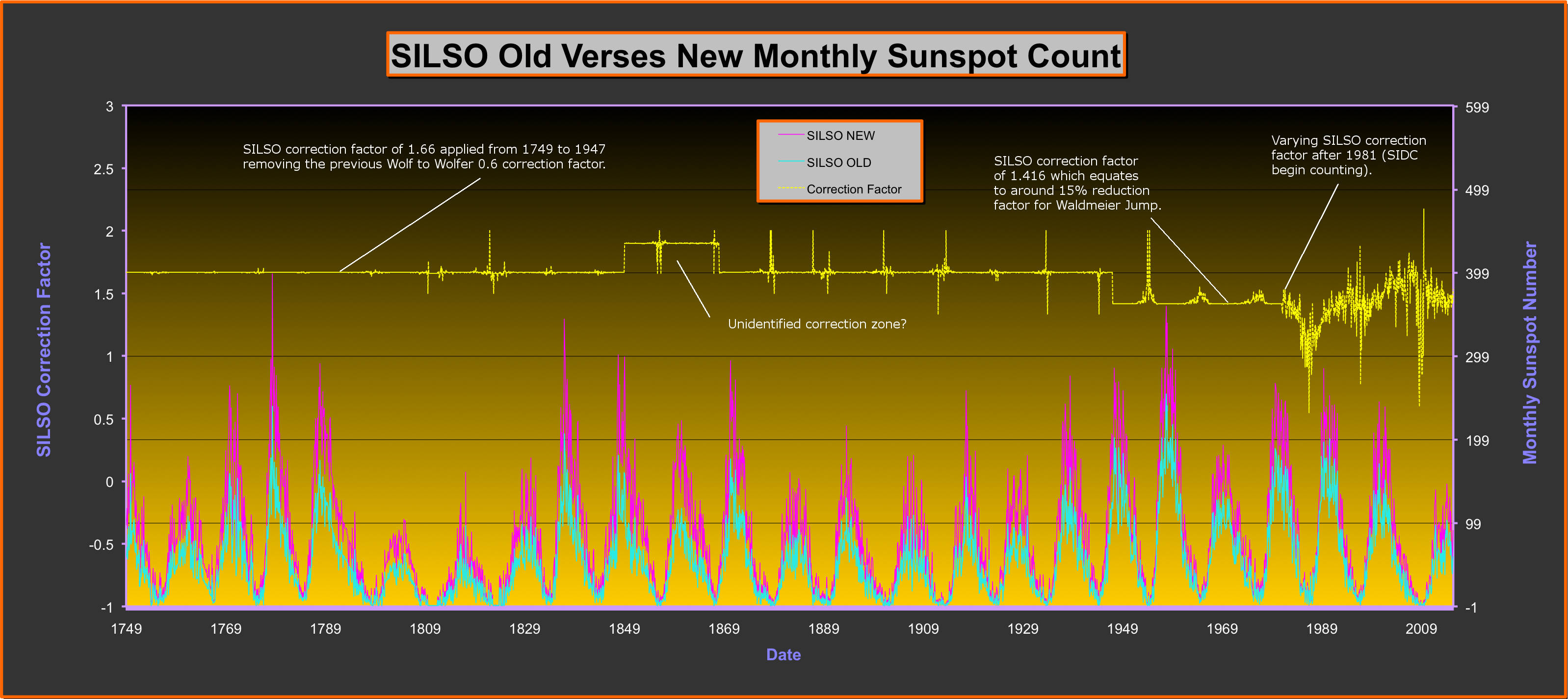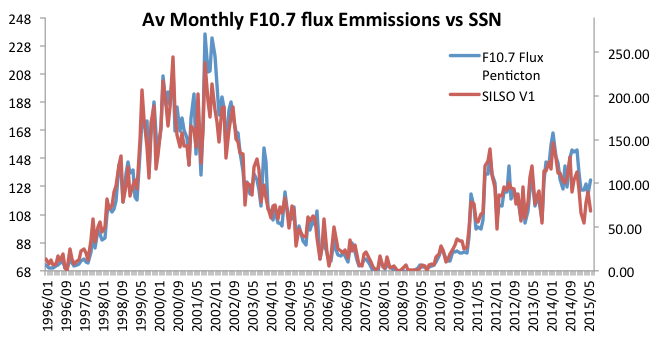|
|
Post by lsvalgaard on Jul 26, 2015 22:23:34 GMT
|
|
|
|
Post by lsvalgaard on Jul 26, 2015 22:58:45 GMT
|
|
|
|
Post by gsharp on Jul 27, 2015 1:28:47 GMT
More confusion going on here. I am NOT discussing the Group Sunspot Number. My questions and graph are aimed at the normal international sunspot number (old SIDC values). So I will ask the questions again.  www.landscheidt.info/images/SILSO.png www.landscheidt.info/images/SILSO.png for a full size view What is the % correction factor for the Waldmeier Jump between 1947 and 1981?
How is the correction factor calculated from 1981 to present?
Why have the original SILSO V1 values between approx 1840-1870 been raised in V2? |
|
|
|
Post by lsvalgaard on Jul 27, 2015 19:06:13 GMT
And I'll refer you AGAIN to Clette et al. 2014 that spells all that out in detail. Also to the abstract of our upcoming talk at the IAU General Assembly in Hawaii on August 7th: DE.2.04 – The new Sunspot and Group Numbers: a full recalibration After a 4-year research effort, we present here the first end-to-end revision of the Sunspot Number since the creation of this reference index of solar activity by Rudolf Wolf in 1849 and the simultaneous re-calibration of the Group Number, which leads to the elimination of the past incompatibility between those two independent data sets. Most corrections relied entirely on original sunspot data, using various approaches. Newly recovered historical sunspot records were added and a critical data selection was applied for the 17th and 18th century, confirming the low solar activity during the Maunder Minimum. Over the 19th century, the k scaling coefficients of individual observers were recomputed using new statistical methodologies, like the "backbone" method resting on a chain of long-duration observers. After identifying major changes in the observing methods, two major inhomogeneities were corrected in 1884 in the Group Number (~40% upward drift) and in 1947 in the Sunspot Number (~20% overestimate). Finally, a full re-computation of the group and sunspot numbers was done over the last 50 years, using all original data from the 270 stations archived by the World Data Center - SILSO in Brussels. The new Sunspot Number series definitely exclude a progressive rise in average solar activity between the Maunder Minimum and an exceptional Grand Maximum in the late 20th century. Residual differences between the Group and Sunspot Numbers over the past 250 years confirm that they reflect different properties of the solar cycle and that the average number of spots per group varies over time, as it just happened in the recent unexpected evolution of cycles 23 and 24. We conclude on the implications for solar cycle and Earth climate studies and on important new conventions adopted for the new series: new unit scales (constant "heritage" factors 0.6 and 12.08 dropped for the Sunspot and Group Numbers respectively), new SN and GN symbols and a new version-tracking scheme implemented at the WDC-SILSO, as a framework open to future improvements of those unique data series. Author(s): Frédéric Clette2, Leif Svalgaard3, Edward W Cliver1, José M Vaquero4, Laure Lefèvre2 Institution(s): 1. National Solar Observatory, 2. Observatoire Royal de Belgique, 3. Stanford University, 4. Universidad de Extremadura The group numbers and the sunspot number go hand in hand [since the number of groups is half of the SSN]. The weight factor is discussed here: www.leif.org/research/Effect-of-Sunspot-Weighting.pdfbut is not even used in the 'official' recalculation from 1981 on as it is done without reference to Locarno. The 1849-1861 SSN were too low for several reasons: e.g. use of a different telescope in Bern, mixture of Schwabe and Wolf data, etc. Figure 30 of www.leif.org/research/Revisiting-the-Sunspot-Number.pdf shows that cycle 11 is too low. The [peer-reviewed] revised data are the best we [and anyone] can do with the data available. We are open for valid suggestions if you think you can do better. The following presentation may be of interest: www.leif.org/research/The-July-Seminars-2015.pdfThere is now widespread acceptance of our findings. |
|
|
|
Post by lsvalgaard on Jul 27, 2015 19:17:46 GMT
More confusion going on here. I am NOT discussing the Group Sunspot Number. My questions and graph are aimed at the normal international sunspot number (old SIDC values). So I will ask the questions again. The old numbers are no longer of interest. If you are so confused, go study carefully the papers and presentations I have referred you to. We can understand there is confusion if you don't take the trouble to educate yourself a bit. |
|
|
|
Post by gsharp on Jul 28, 2015 4:21:28 GMT
More confusion going on here. I am NOT discussing the Group Sunspot Number. My questions and graph are aimed at the normal international sunspot number (old SIDC values). So I will ask the questions again. The old numbers are no longer of interest. If you are so confused, go study carefully the papers and presentations I have referred you to. We can understand there is confusion if you don't take the trouble to educate yourself a bit. I have read 80 page the Clette paper (mostly your work) several times but still do not have direct answers to my questions. If you are not willing to answer the questions directly we can only assume you are trying to hide something?? |
|
|
|
Post by lsvalgaard on Jul 28, 2015 4:48:17 GMT
I have here answered your questions fully. What more is there to say? The old numbers are not of interest as they are flawed.
For example: you ask "How is the correction factor calculated from 1981 to present?" The answer is that there is no correction factor for that period. What is not to understand?
Do I take it that you are unnerved by the new series? Instead of being excited that we finally got it right.
|
|
|
|
Post by lsvalgaard on Jul 28, 2015 4:52:16 GMT
"trying to hide something?"
A Danish proverb seems to be fitting here: "a thief thinks everybody steals".
|
|
|
|
Post by gsharp on Jul 28, 2015 5:59:12 GMT
The new series looks to be one's mans version of how he thinks it should be.
The majority of the Rudolf Wolf observed numbers are now out of sync with Wolfer along with the values before Wolf's time time based on some very unconvincing data. This is not good enough and certainly not worthy of changing the International Sunspot Record.
The 1947 - 1981 Waldmeier correction factor looks too low, your own papers look to suggest 20-22% would be a more accurate figure. My own research after counting sunspots daily for the last 6 years suggests the same.
The changes to the post 1981 figures look to be mainly based on the SSN divergence away from some form of F10.7 series. Even if the F10.7 data series you used is correct it does not mean that SSN always have to follow. This is a major mistake.
I think SILSO has jumped too quick and not done their homework thoroughly. I hope they continue to also count using the old method going forward and that we are not forced to follow the new regime into the future.
And the revised GSN is a disgrace, a proper rebuttal of Leussu(2013) would be required as a minimum before any changes to the GSN could be considered.
|
|
|
|
Post by lsvalgaard on Jul 28, 2015 6:43:12 GMT
Your post shows that you have not looked carefully at the problem. E.g. your notion that the number after 1981 is 'some kind of F10.7'. Leussu et al. do not need a rebuttal, as they are simply wrong. The proper way is to reassess the group count as Schatten and I do in www.leif.org/research/Reconstruction-of-Group-Number-1610-2015.pdfThere is no difference between the old and the new 'method'. One simply counts groups and spots as before. The weight factor is not constant, but varies with activity as shown in www.leif.org/research/Effect-of-Sunspot-Weighting.pdfBottom line: you have failed to consider the data and the recent papers. The old series are now officially dead. |
|
|
|
Post by gsharp on Jul 28, 2015 6:53:14 GMT
We will see how your reconstruction stands up to the test of time...I expect rebuttal in the literature in the not too distant future. But I do agree the Waldmeier Jump needs to be backed out of the record. The SILSO attempt does not go far enough. Comment?? On another issue...  Pentiction SC23/24 F10.7 flux looking pretty good against SILSO V1?? |
|
|
|
Post by lsvalgaard on Jul 28, 2015 13:45:40 GMT
|
|